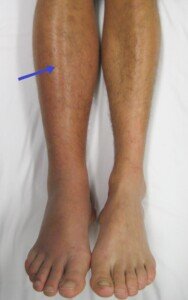
Can DVT pain in the calve, and the pain of a pulled muscle in the calve, be distinguished?
DVT stands for deep vein thrombosis: a blood clot.
A blood clot in the calve can cause aching or discomfort. So can a pulled or strained muscle in this region.
If there a way to tell the difference between blood clot pain and that which results from a sore or pulled muscle in the calve?
“It is going to be difficult,” says Seyed-Mojtaba Gashti, MD, a board certified vascular surgeon with Broward Health Medical Center in Florida.
“Both most likely would present with achy kind of pain,” continues Dr. Moji.
“Perhaps the history may be more important here; a pulled muscle most likely would happen with some kind of trauma or activity as opposed to pain related to deep vein thrombosis, which most likely would happen in an individual after some inactivity (post-op, cast, long trips, etc.).
“The pain from DVT most likely would also come about slowly rather than suddenly, and be associated with swelling.”

DVT in lower leg. James Heilman, MD, CreativeCommons
As you can see, a better way to tell the difference between a DVT and a pulled muscle is by evaluating the preceding activity—or lack thereof.
The suspicion for a DVT is heightened if the symptom of what feels like a pulled muscle in one of your calves is accompanied by a redness or warmth in that area, and the discomfort persisting even when you’re seated and not moving the leg.
Another suspicious symptom is that of tenderness to the touch.
Nevertheless, if you suspect a blood clot, head immediately to the emergency room. An ultrasound can make the proper diagnosis.

Dr. Gashti specializes in the diagnosis and treatment of vascular disease including abdominal and aortic aneurysm.
 Lorra Garrick has been covering medical, fitness and cybersecurity topics for many years, having written thousands of articles for print magazines and websites, including as a ghostwriter. She’s also a former ACE-certified personal trainer.
Lorra Garrick has been covering medical, fitness and cybersecurity topics for many years, having written thousands of articles for print magazines and websites, including as a ghostwriter. She’s also a former ACE-certified personal trainer.









































